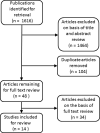Surgical management of Patulous Eustachian tube: A systematic review
- PMID: 25646902
- PMCID: PMC4725712
- DOI: 10.1002/lary.25168
Surgical management of Patulous Eustachian tube: A systematic review
Abstract
Objectives: Patulous Eustachian tube (PET) is a challenging clinical problem with limited medical and surgical options. The current study systematically reviews the literature to determine the safety and efficacy of surgical treatments for PET.
Data sources: Medline, Google Scholar, and Cochrane databases.
Methods: Studies evaluating the surgical management of PET were extracted based on defined inclusion criteria. Data including surgical techniques, outcomes, and complications were extracted and analyzed.
Results: A total of 1,616 studies were retrieved from the initial search. Of these, 14 studies comprising a total of 226 patients (253 sides) met inclusion criteria and were evaluated for surgical techniques, patient outcomes, and complications. As defined by the Oxford Center for Evidence-Based Medicine (Oxford, UK), all studies were classified as level 4 evidence. The most commonly reported techniques were ET plugging (3 studies), PE tube placement (2 studies), and suture ligation (2 studies). Postoperative follow-up ranged from 2 to 60 months (mean, 20.6 months). Outcome measures varied significantly between individual studies, with overall symptom improvement reported between 22% and 100% (mean 72.4%; 95% CI, 62.5%-81.2%). A low incidence of minor complications was reported in nine of 14 studies.
Conclusions: Current literature evaluating the surgical management of PET is limited and comprised entirely of level 4 studies. Comparisons between techniques were not possible due to the small number of studies and variable outcome measures. Future larger studies evaluating defined outcomes and quality-of-life measures are needed to determine the comparative efficacy of surgical treatments for this challenging condition.
Keywords: Patulous eustachian tube; autophony; eustachian; eustachian tube dysfunction; outcomes; patulous; surgery.
© 2015 The American Laryngological, Rhinological and Otological Society, Inc.
Figures
Similar articles
-
Systemic pharmacological treatments for chronic plaque psoriasis: a network meta-analysis.Cochrane Database Syst Rev. 2021 Apr 19;4(4):CD011535. doi: 10.1002/14651858.CD011535.pub4. Cochrane Database Syst Rev. 2021. Update in: Cochrane Database Syst Rev. 2022 May 23;5:CD011535. doi: 10.1002/14651858.CD011535.pub5. PMID: 33871055 Free PMC article. Updated.
-
Treatment Effectiveness for Symptoms of Patulous Eustachian Tube: A Systematic Review.Otol Neurotol. 2015 Dec;36(10):1593-600. doi: 10.1097/MAO.0000000000000900. Otol Neurotol. 2015. PMID: 26595716
-
A rapid and systematic review of the clinical effectiveness and cost-effectiveness of topotecan for ovarian cancer.Health Technol Assess. 2001;5(28):1-110. doi: 10.3310/hta5280. Health Technol Assess. 2001. PMID: 11701100
-
Systemic pharmacological treatments for chronic plaque psoriasis: a network meta-analysis.Cochrane Database Syst Rev. 2017 Dec 22;12(12):CD011535. doi: 10.1002/14651858.CD011535.pub2. Cochrane Database Syst Rev. 2017. Update in: Cochrane Database Syst Rev. 2020 Jan 9;1:CD011535. doi: 10.1002/14651858.CD011535.pub3. PMID: 29271481 Free PMC article. Updated.
-
Drugs for preventing postoperative nausea and vomiting in adults after general anaesthesia: a network meta-analysis.Cochrane Database Syst Rev. 2020 Oct 19;10(10):CD012859. doi: 10.1002/14651858.CD012859.pub2. Cochrane Database Syst Rev. 2020. PMID: 33075160 Free PMC article.
Cited by
-
Mid-term evaluation of the surgical management of patulous Eustachian tube dysfunction: a STROBE observational study.Eur Arch Otorhinolaryngol. 2024 Jun;281(6):2883-2891. doi: 10.1007/s00405-023-08388-w. Epub 2023 Dec 27. Eur Arch Otorhinolaryngol. 2024. PMID: 38151540
-
Lateral Migration of a Eustachian Tube Shim Into the Middle Ear.Laryngoscope. 2025 Aug;135(8):2932-2934. doi: 10.1002/lary.32184. Epub 2025 Apr 12. Laryngoscope. 2025. PMID: 40219703 Free PMC article.
-
Critical distance between the cartilaginous Eustachian tube and the internal carotid artery.Eur Arch Otorhinolaryngol. 2017 Jan;274(1):73-77. doi: 10.1007/s00405-016-4187-y. Epub 2016 Jul 8. Eur Arch Otorhinolaryngol. 2017. PMID: 27392452
-
Patulous Eustachian tube (PET), a practical overview.World J Otorhinolaryngol Head Neck Surg. 2019 Oct 11;5(3):137-142. doi: 10.1016/j.wjorl.2019.08.003. eCollection 2019 Sep. World J Otorhinolaryngol Head Neck Surg. 2019. PMID: 31750425 Free PMC article. Review.
-
Diagnostic approaches to and management options for patulous eustachian tube.Saudi Med J. 2020 Jun;41(6):572-582. doi: 10.15537/smj.2020.6.25083. Saudi Med J. 2020. PMID: 32518922 Free PMC article.
References
-
- Stroud MH, Spector GJ, Maisel RH. Patulous eustachian tube syndrome. Preliminary report of the use of the tensor veli palatini transposition procedure. Arch Otolaryngol. 1974;99:419–421. - PubMed
-
- Pulec JL, Simonton KM. Abnormal Patency of the Eustachian Tube: Report on 41 Cases. The Laryngoscope. 1964;74:267–271. - PubMed
-
- Poe DS. Diagnosis and management of the patulous eustachian tube. Otology & neurotology : official publication of the American Otological Society, American Neurotology Society [and] European Academy of Otology and Neurotology. 2007;28:668–677. - PubMed
-
- Schwartze H. Respiratorische Behebung des Trommelfelles. Arch Ohrenheilkd. 1864
-
- Aedo C MD, Der C. Trompa patulosa. Rev Otorrinolaringol Cir Cabeza Cuello. 2009;69:61–70.
Publication types
MeSH terms
Grants and funding
LinkOut - more resources
Full Text Sources
Other Literature Sources
Medical
Research Materials
Miscellaneous




